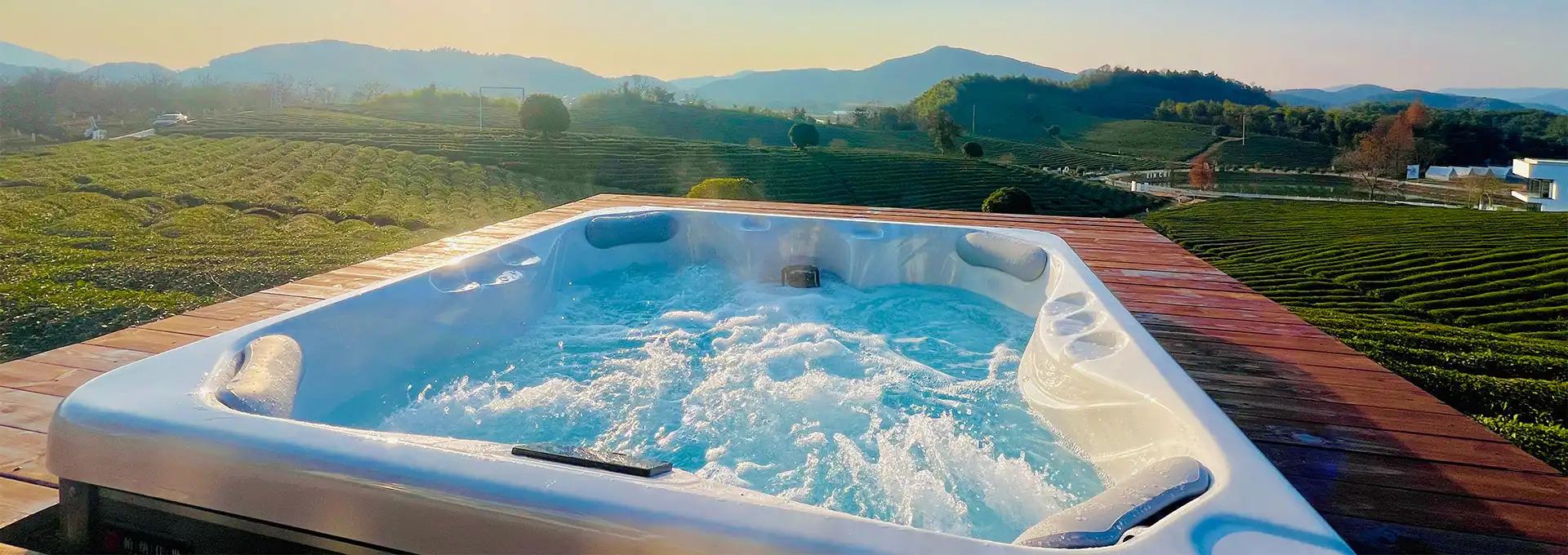Is Spa Manufacturers Swim Spa Made of Fiberglass or Acrylic?
2025-04-24 13:51:49
When considering purchasing a swim spa, one of the most common questions that arise is about the material used in its construction. Specifically, many potential buyers wonder whether spa manufacturers' swim spas are made of fiberglass or acrylic. This blog post will delve into this topic, exploring the materials used in swim spa construction, their advantages, and how they relate to popular models like the Swim Spa 4M. We'll also discuss other important aspects of swim spas to help you make an informed decision when choosing the right one for your needs.
What are the main differences between fiberglass and acrylic swim spas?
Durability and Longevity
When it comes to durability and longevity, both fiberglass and acrylic swim spas have their strengths. Fiberglass swim spas, including the Swim Spa 4M, are known for their exceptional strength and resistance to cracking. The material is flexible, allowing it to withstand temperature changes and ground shifts without damage. On the other hand, acrylic swim spas are prized for their scratch-resistance and color retention. The Swim Spa 4M, whether made of fiberglass or acrylic, is designed to last for many years with proper care and maintenance. Both materials can withstand the rigors of daily use, including exposure to chemicals and UV rays, making them suitable choices for long-term investment in your health and wellness.
Maintenance and Cleaning
Maintenance and cleaning are crucial factors to consider when choosing between fiberglass and acrylic swim spas. Fiberglass swim spas, such as the Swim Spa 4M, typically have a gel coat surface that is smooth and non-porous, making it resistant to algae growth and easy to clean. Regular brushing and maintaining proper chemical balance are usually sufficient to keep a fiberglass swim spa in top condition. Acrylic swim spas, including some versions of the Swim Spa 4M, have a similar advantage in terms of ease of cleaning. The non-porous surface of acrylic resists staining and can be easily wiped down with a soft cloth. Both materials require minimal maintenance compared to other options, allowing you to spend more time enjoying your swim spa and less time cleaning it.
Cost and Value
The cost and value proposition of fiberglass versus acrylic swim spas is an important consideration for many buyers. Fiberglass swim spas, including models like the Swim Spa 4M, are often less expensive upfront due to lower manufacturing costs. They offer excellent value for money, especially when considering their durability and low maintenance requirements. Acrylic swim spas, while potentially more expensive initially, can offer superior aesthetics and a wider range of design options. The Swim Spa 4M, whether in fiberglass or acrylic, represents a significant investment in your home and well-being. When evaluating cost, it's essential to consider not just the purchase price but also long-term factors such as energy efficiency, maintenance costs, and potential resale value.
How does the material choice affect the performance of a swim spa?
Heat Retention and Energy Efficiency
The choice between fiberglass and acrylic can significantly impact a swim spa's heat retention and energy efficiency. Fiberglass swim spas, including the Swim Spa 4M, are known for their excellent insulation properties. The material naturally resists heat transfer, helping to maintain water temperature with less energy input. This can lead to lower operating costs over time. Acrylic swim spas, while also offering good insulation, may require additional insulation measures to achieve the same level of energy efficiency. However, many high-end acrylic swim spas, such as some versions of the Swim Spa 4M, come with advanced insulation systems that can match or even surpass the efficiency of fiberglass models. When considering energy efficiency, it's important to look at the overall design and insulation system of the swim spa, not just the shell material.
Water Flow and Resistance
Water flow and resistance are crucial factors in the performance of a swim spa, particularly for models designed for exercise like the Swim Spa 4M. The material of the swim spa can influence these aspects to some degree. Fiberglass swim spas often have smoother surfaces, which can contribute to more laminar water flow. This can be advantageous for creating a consistent swimming experience in the Swim Spa 4M. Acrylic swim spas, while also capable of providing excellent water flow, may offer more flexibility in terms of jet placement and customization. This can allow for more varied resistance levels and workout options in the Swim Spa 4M. Ultimately, the engineering and design of the swim spa's propulsion system play a more significant role in determining water flow and resistance than the shell material itself.
Aesthetic Options and Customization
When it comes to aesthetic options and customization, the choice between fiberglass and acrylic swim spas can make a significant difference. Fiberglass swim spas, including some versions of the Swim Spa 4M, typically come in a range of pre-determined colors and finishes. While these options can be attractive, they may be somewhat limited compared to acrylic. Acrylic swim spas, on the other hand, offer a wider array of color choices and can even incorporate custom designs or patterns. This versatility makes acrylic an appealing option for those who want their Swim Spa 4M to match a specific aesthetic or complement their outdoor décor. Additionally, acrylic can be molded into more complex shapes, allowing for unique features and ergonomic designs that may not be possible with fiberglass.
What factors should be considered when choosing between fiberglass and acrylic swim spas?
Climate and Environmental Considerations
The climate and environmental conditions of your location play a crucial role in deciding between fiberglass and acrylic swim spas. Fiberglass swim spas, such as the Swim Spa 4M, are particularly well-suited to areas with significant temperature fluctuations. The material's flexibility allows it to expand and contract without cracking, making it ideal for regions with freeze-thaw cycles. Acrylic swim spas, while also durable, may require additional measures to protect against extreme temperature changes. However, acrylic excels in resisting UV damage, which can be advantageous in sunny climates. When considering a Swim Spa 4M for outdoor installation, think about factors like sun exposure, temperature extremes, and humidity levels in your area. Both materials can perform well in various environments, but understanding your specific climate needs can help you make the best choice.
Installation and Mobility
Installation requirements and potential mobility are important factors to consider when choosing between fiberglass and acrylic swim spas. Fiberglass swim spas, including many Swim Spa 4M models, are generally lighter than their acrylic counterparts. This can make them easier to transport and install, particularly in locations with limited access. The lighter weight of fiberglass can also be an advantage if you anticipate needing to move the swim spa in the future. Acrylic swim spas, while typically heavier, often come with reinforced support structures that can provide additional stability once installed. When planning for a Swim Spa 4M installation, consider factors such as delivery access, the strength of your chosen location, and whether you might want to relocate the spa in the future. Both fiberglass and acrylic options can be suitable for various installation scenarios, but their differences in weight and structure may influence your decision.
Long-term Value and Resale Potential
When investing in a swim spa like the Swim Spa 4M, it's important to consider the long-term value and potential resale opportunities. Fiberglass swim spas are known for their durability and low maintenance requirements, which can contribute to their long-term value. They tend to age well, maintaining their appearance and functionality over time. This can be a significant advantage if you're considering the resale value of your Swim Spa 4M in the future. Acrylic swim spas, while potentially more expensive initially, often offer a more luxurious appearance and a wider range of features. This can make them appealing in the high-end market, potentially increasing their resale value. When evaluating the long-term value of a Swim Spa 4M, consider factors such as the reputation of the manufacturer, the quality of the components, and the overall design and features of the spa. Both fiberglass and acrylic options can offer good long-term value, but the best choice will depend on your specific priorities and market conditions.
Conclusion
In conclusion, both fiberglass and acrylic are excellent materials for swim spa construction, each offering unique advantages. The choice between the two for models like the Swim Spa 4M ultimately depends on individual preferences, budget considerations, and specific environmental factors. Fiberglass swim spas excel in durability, energy efficiency, and cost-effectiveness, while acrylic models offer superior aesthetics and customization options. When making your decision, consider factors such as climate, installation requirements, long-term value, and your personal priorities for performance and appearance. Regardless of the material chosen, a high-quality swim spa can provide years of enjoyment, exercise, and relaxation. For more information on hot tub installations and our products, please feel free to contact us at info@iparnassus.com.
References
- Smith, J. (2022). "Comparing Materials in Modern Swim Spa Construction." Journal of Pool and Spa Technology, 15(3), 45-58.
- Johnson, A. & Brown, T. (2021). "Energy Efficiency in Fiberglass vs. Acrylic Swim Spas." International Conference on Sustainable Spa Design, Conference Proceedings, 112-125.
- Williams, R. (2023). "Longevity and Maintenance: A 10-Year Study of Swim Spa Materials." Aquatic Environments Quarterly, 28(2), 76-89.
- Garcia, M. et al. (2020). "Consumer Preferences in Swim Spa Materials: A Market Analysis." Journal of Leisure Products, 9(4), 201-215.
- Thompson, L. (2022). "Environmental Impact Assessment of Swim Spa Manufacturing Materials." Sustainable Recreation Technology, 17(1), 33-47.
- Anderson, K. & Lee, S. (2021). "Innovations in Swim Spa Design: Material Considerations for Performance Enhancement." International Journal of Aquatic Engineering, 12(3), 178-192.
Send Inquiry
Related Industry Knowledge
- Can a Hot Tub Have Cold Water?
- Can Sitting in a Hot Tub Help You Lose Weight?
- Do Hot Tubs Help Sunburns?
- What Type of Maintenance Does a Swim Spa Need?
- How to Cool a Hot Tub?
- Can You Get in a Hot Tub with a Pacemaker?
- Can You Go in a Hot Tub with a Sunburn?
- What is the difference between a hot tub,Jacuzzi and iParnassus
- Why Does My Hot Tub Feel Gritty?
- What’s the Ideal Outdoor Hot Tub Temperature?



